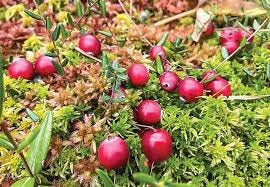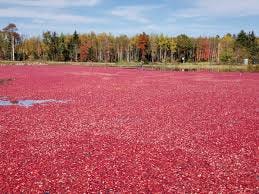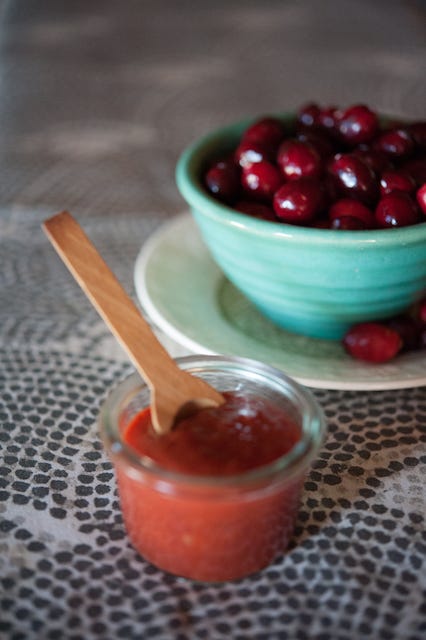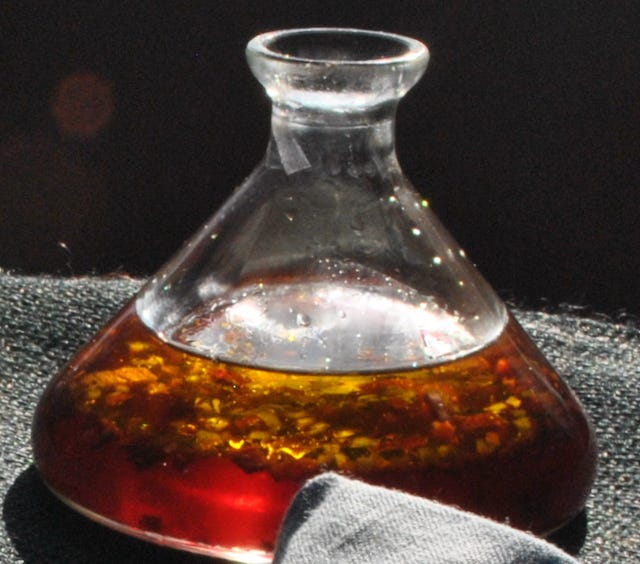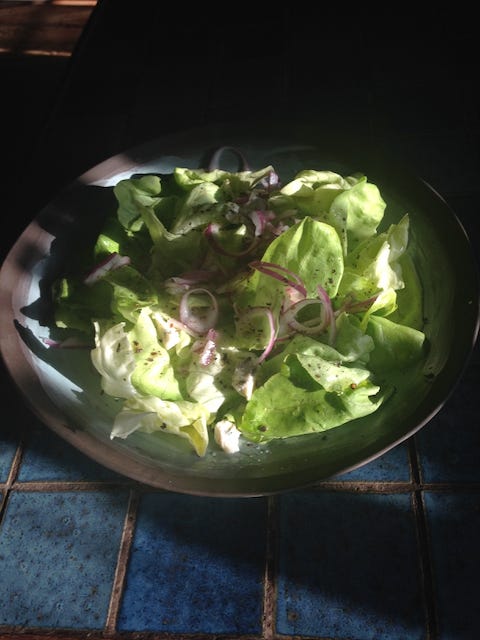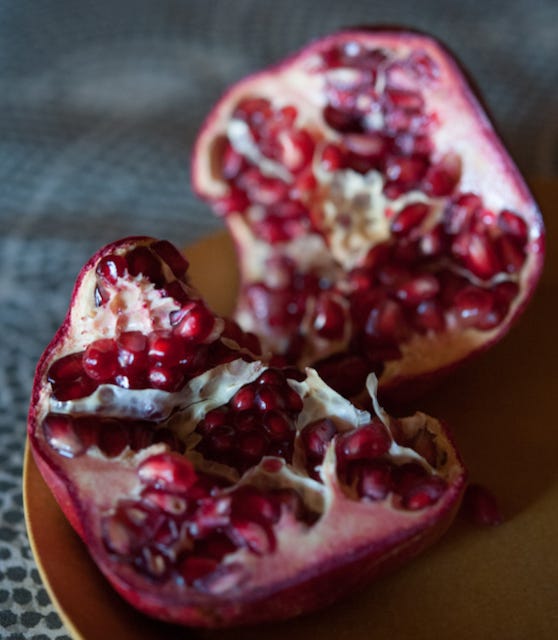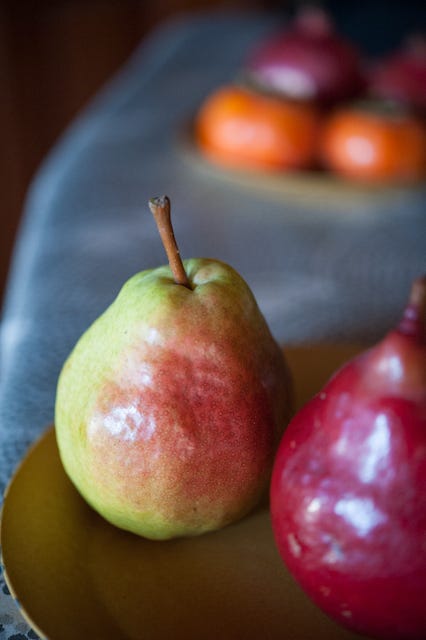Kitchen: Cranberries!
The athletes of the fruit world are essential to the season, delicious in chutney, salsa, vinaigrette, mignonette, other sauces, fruit compote, pies, tarts, and more.
Before a cranberry is sent to market, it must pass the bounce test. Berries that do not bounce are either processed or discarded. Despite passing this test, not all berries retain their bounce and it is essential to sort them before you begin to cook. But don’t worry about making them bounce; instead, just spread them on a baking sheet and look for soft or brown berries.
Cranberries get their name from how they look in the spring, when their flowers bloom: Then, a cranberry bog evokes a green and white sea, as the flowers resemble tiny swans or cranes. When the fruit is ready for harvest, the bogs are flooded and the berries float on top of the water, giving it a crimson glow, a vast scarlet sea sometimes stretching all the way to the horizon.
Cranberries are native to North America, with commercial crops in Oregon, Washington, Wisconsin, and throughout New England. Although they are not grown in California, the region’s Russian settlers required cranberries and received them first by boat and wagon and then by train car. The closest bogs were in southern Oregon, near the coast. Today, Bandon, Oregon, produces about 30 million pounds, enough to satisfy Oregonians and supply about 5 percent of the nation’s crop. The harvest is celebrated with a festival each year in mid September.
Cranberry Chutney • Makes about 4 pints
This chutney is both beautiful and delicious. Enjoy it as part of a cheeseboard, with roasted and grilled meats, including turkey, and on sandwiches. It is outstanding with curried turkey salad, too.
8 cups cranberries, rinsed and picked through for soft berries 8 garlic cloves, minced 2 red onions, cut into small dice 2 or 3 serranos, stemmed, seeded, and minced 2 cups currants 2 to 2 ½ cups granulated sugar 2 cups cranberry vinegar or apple cider vinegar 2-inch piece of ginger, peeled and grated ½ teaspoon each: ground cardamom, ground clove, ground cayenne and ground allspice 3 pears, peeled, cored, and cut into small dice 2 teaspoons kosher salt
Put the cranberries into the work bowl of a food processor and pulse several times to mince them evenly; work in batches as needed. Transfer the cranberries to a large saucepan and add the garlic, onion, serrano, currants, sugar, vinegar, spices, and pears. Add the salt and stir.
Set the saucepan over medium-low heat and simmer gently for about 30 minutes, until the mixture begins to thicken. Stir now and then as it cooks.
Carefully taste the chutney and adjust for acid and sweetness. If it tastes flat, stir in another teaspoon of salt.
Ladle the chutney into hot sterilized jars, seal, cool, and store in the refrigerator for up to 2 months.
Cranberry Salsa • Makes about 2 ½ to 3 cups
In the 1990s, a young couple in San Francisco produced several commercial salsas, including one made with cranberries. I loved it and soon began making my own version. It is delicious with roasted meats, especially pork and all kinds of poultry.
1 package (12 ounces) cranberries, rinsed, soft berries discarded 1 or 2 serranos, stemmed, seeded, and minced 1 small red onion, cut into small dice Grated zest of 1 orange ¼ cup sugar Kosher salt 2 tablespoons vinegar (cranberry, pomegranate, white wine, or red wine) ⅓ cup extra virgin olive oil, plus more as needed 1 tablespoon minced fresh cilantro 1 teaspoon minced fresh sage Black pepper in a mill
Put the cranberries into the work bowl of a food processor and pulse until the berries are evenly minced. Transfer them to a medium bowl, add the serranos, onion, and orange zest, and toss. Add the sugar, season with salt, add the vinegar, and stir well, until the sugar is dissolved. Add the olive oil, cilantro and sage, and toss again.
Taste and correct for salt and acid balance, adding more olive oil if the mixture is too tart and a few more pinches of salt if it tastes flat. Season with black pepper, transfer to a serving bowl, cover, and let rest 30 minutes before serving.
Store, covered, in the refrigerator for 2 to 3 days.
Remove from the refrigerator 30 minutes before serving.
Cranberry Vinaigrette • Makes 1 ⅓ cups
A simple green salad, maybe with thinly sliced red onion and toasted pecans, dressed with cranberry vinaigrette is an easy and delicious way to add seasonal flavor to your holiday table. You’ll also enjoy this dressing on salads of thinly sliced red onion, peeled and sliced citrus, rice salads, wild rice salads, and salads topped with sliced smoked turkey
⅓ cup cranberry vinegar (see Note below) 1 teaspoon grated orange zest Pinch of ground allspice Pinch of granulated sugar, plus more as needed Generous pinch of kosher salt Black pepper in a mill ½ cup hazelnut oil ⅓ to ½ cup peanut oil or mildly flavored olive oil
Put the vinegar, orange zest, allspice, sugar, and salt in a small bowl. Add several turns of black pepper and taste the mixture. If it seems flat – i.e., the flavor of cranberries hasn't quite blossomed – add another pinch of sugar and another pinch of salt.
Whisk in the oils.
Use right away or cover and refrigerate for a day or two.
Note: To make cranberry vinegar, rinse a 12-ounce package of cranberries and pick out and discard any soft berries. Put the cranberries into the work bowl of a food processor and pulse several times, until they are reduced to small bits. Transfer to a quart glass jar and fill the jar with white wine vinegar or Champagne vinegar. Cut two squares or circles slightly larger than the jar's opening and set it on top of the jar. Add the lid and ring and set in a cool, dark place for at least 2 days and as long as 10 days. Strain through several layers of cheesecloth and store in a bottle with a cork, not a metal closure.
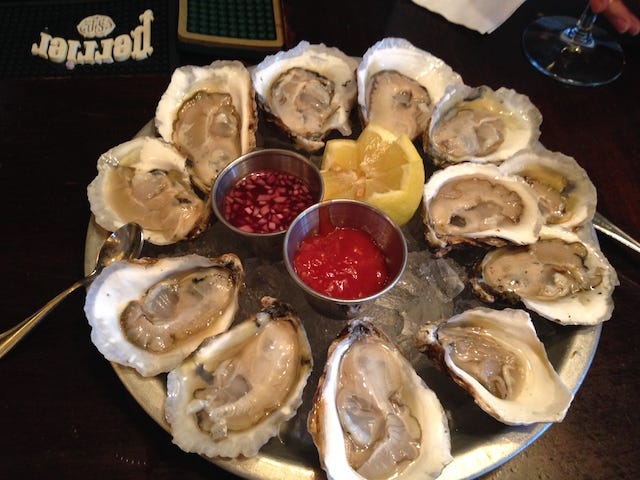
Cranberry Mignonette • Makes about 1 cup
Oysters on the half shell are a favorite during the winter holidays, from Thanksgiving through New Year's Day. A mignonette dresses them up deliciously and this one mirrors the flavors of the season.
1 small shallot, minced 1 teaspoon minced serrano chile 3 tablespoons fresh cranberries, minced ½ teaspoon grated tangerine or orange zest ¾ cup cranberry vinegar ⅓ cup freshly squeezed orange or tangerine juice 3 or 4 generous pinches of kosher salt Black pepper in a mill
Put the shallot, serrano, cranberries, zest, vinegar and juice into a small bowl and stir. Add several very generous turns of black pepper.
Use right away or refrigerate, covered, for 3 to 4 days.
Cranberry Mayonnaise • Makes about 1 ½ cups
Many people, myself included, think the best reason to prepare a traditional Thanksgiving meal is the leftovers. From turkey sandwiches to turkey-barley soup, turkey gumbo and turkey risotto, the feast improves the day after the main meal and continues to do so until the last bit of stock has been used. If you like your turkey sandwiches slathered with mayonnaise, you might try this one, with its flavors of the season. It is more subtle than cranberry sauce, which some people love but others find too sweet.
2 large egg yolks, at room temperature 1 teaspoon kosher salt Several turns of white pepper in a mill 3 tablespoons extra-virgin olive oil ¾ cup mildly flavored olive oil or avocado oil 3 tablespoons cranberry vinegar 1 tablespoon freshly squeeze tangerine or orange juice
Put the egg yolks, salt, and pepper into a wide, deep bowl and use a balloon whisk to beat the mixture until the eggs are pale and thick. Begin adding the oil a teaspoon at a time, whisking it in completely before adding more. As the sauce thickens, you may add progressively more oil and, finally, the vinegar and juice.
If the mixture seems too thick, thin it with a tablespoon of water.
Cover and refrigerate for two hours before using. It will keep for several days.
Roast Duckling with Cranberry-Mustard Sauce • Serves 2 to 4
Luscious duck meat, which is all dark, blossoms with both cranberries and mustard.
1 duckling, about 5 pounds Kosher salt Black pepper in a mill 1 yellow onion, cut in half 1 orange, stuck with 8 whole cloves 2 cups (about 6 ounces) fresh cranberries 2 to 6 tablespoons sugar 1 cup duck stock 1 teaspoon minced orange zest 2 tablespoons Dijon mustard 2 teaspoons butter
Preheat the oven to 400 degrees.
Rinse the duck inside and out under cool running water and pat dry with a tea towel. Season the cavity with salt and pepper and put the onion and orange inside. Prick the skin of the duck all over to allow the fat to run off during roasting. Set the duck on a rack in a roasting pan, breast side down, and cook until the thigh meat is tender and the juices run clear when pricked with a fork, about 45 to 60 minutes.
While the duck is cooking, put the cranberries into a small saucepan with 2 tablespoons of the sugar. Simmer over very low heat until the berries pop and are quite soft. Purée with an immersion blender or in a food processor and press through a sieve or food mill. Set aside.
When the duck is done, remove it from the oven, set it on clean work surface, and cover loosely with aluminum foil.
Set the roasting pan over medium heat and deglaze the pan with some of the duck stock. Add the rest of the stock and simmer until the mixture is reduced by one-third, about 10 minutes. Stir in the cranberry purée, the orange zest, the mustard, and enough of the remaining sugar to balance the sauce. Taste and season with salt and pepper. Whisk in the butter, a teaspoon at a time. Quickly remove the sauce from the heat and pour into a sauce boat.
Carve the duck, cutting the legs and thighs between the joints and setting them on a serving platter. Remove the breasts and cut each one into several ¼-inch thick slices and add to the platter. Set the sauce alongside and enjoy right away.
Cranberry-Beaujolais Soup • Serves 4 to 6
One year, I served this soup with homemade orange zest pasta as dessert on Thanksgiving. You can also enjoy it as a beverage to sip alongside a warming fire as you read a favorite book.
1 package (12 ounces) fresh cranberries ½ cup sugar + more to taste 5 whole cloves 2 cardamom pods, lightly crushed 1-inch piece of cinnamon stick 2 cups Beaujolais or Gamay 1 cup freshly squeezed tangerine or orange juice 1 tablespoon julienned tangerine or orange zest 2 tablespoons creme fraiche, optional
Put the cranberries, sugar, and 2 cups of water in a heavy pot and bring to a boil, stirring constantly until the sugar is dissolved. Tie the cloves and cinnamon in a square of cheesecloth or put it into a tea infuser, lower it into the cranberry mixture, and simmer very gently until the cranberries pop and are very soft, about 10 to 15 minutes.
Remove from the heat, cover, and let cool for 15 to 20 minutes. Use tongs to remove and discard the spices.
Using an immersion blender, purée the soup and strain it into a clean saucepan. (If you do not have an immersion blender, purée with a traditional blender or food processor.)
Set over low heat, stir in 1 ½ cups of the wine and the juice and simmer for 10 minutes. Taste and add sugar if the soup is too tart. Remove from the heat and stir in the remaining wine.
Ladle into cups or mugs, top each serving with a slash of creme fraiche and some zest, and enjoy right away.
Pear, Cranberry, Orange, & Pomegranate Compote • Serves 4 to 6
This dessert is bright, refreshing, and won’t leave feeling overly stuffed. You can serve it warm or chilled; both versions are delicious.
Juice of 1 lemon 4 to 6 Bartlett, Anjou, or Comice pears 3 cups fruity white wine, such as gewurztraminer or riesling 1 cup sugar, plus more to taste 2 tablespoons dried orange peel 2 tablespoons grated orange zest 2 thin slices fresh ginger 4 cups fresh cranberries, washed and picked Arils from 1 pomegranate 1 cup fresh orange segments, membranes removed Créme fraiche, optional
Fill a medium mixing bowl half full with water and add the lemon juice.
Using a vegetable peeler, peel the pears, leaving the stems in place and setting each one into the acidulated water after peeling.
Pour the wine into a sauce pan just large enough to hold the pears. Add the sugar, orange peel, orange zest and ginger and bring to a boil over medium heat. Stir until the sugar is dissolved.
Drain the pears and carefully set them, stem end up, in the syrup. Add enough water to cover the pears completely. Bring the liquid to a boil, reduce the heat and simmer until the pears are tender when pierced with a bamboo skewer. Using a slotted spoon, transfer the pears to a bowl and set them aside.
Increase the heat and simmer the syrup until it is reduced by one third, about 10 minutes. Stir in the cranberries and cook until they are tender, about 10 minutes; be certain all cranberries have popped open. Remove from the heat. Use a tong to remove and discard the ginger.
Return the pears to the cranberry mixture, turning them on their sides so that they are fully submerged. Let rest at room temperature for 2 hours, turning the pears now and then so that they take on color evenly, or refrigerate for up to 2 days.
To serve, gently reheat the pears and the syrup. Set a pear in the center of a soup plate, fold the pomegranates and orange segments into the cranberry mixture, and divide among the servings. Top with a dollop of créme fraiche, if using, and enjoy right away.
The compote may also be served chilled, neat or with ice cream.
Cranberry Walnut Tart • Serves 6 to 8
The first commercial walnut trees were brought into California from Chile in 1867. Today the state produces 99 percent of the domestic walnut crop and is second only to China in world-wide production. There are more than 335,000 acres of walnut trees in the Central Valley, with small orchards and even single trees scattered throughout the state. The entire crop is harvested in late summer and early fall; look for the new crop in farmers markets and stores in October.
Pastry Dough, see recipe below 3 eggs ½ cup, packed, brown sugar 1 cup agave nectar or maple syrup 4 ounces (½ cup, 1 stick) butter, melted 1 teaspoon vanilla 1 tablespoon brandy 1 tablespoon fresh orange juice 2 teaspoons grated orange zest 1 teaspoon cinnamon ¾ teaspoon salt ¾ cup fresh cranberries, minced 1 cup (4 ounces) walnuts, toasted and coarsely chopped
First, make the pastry dough and chill it according to the instructions in the reicpe.
On a well floured surface, roll out the dough into a 12 inch circle. Carefully lift the dough and put it into a 10-inch tart pan with removable bottom, pressing it gently at the inner edge and crimping it all around. Cover and refrigerate until ready to fill.
Preheat the oven to 350 degrees.
Put the eggs into a medium bowl and whisk until they are thick and frothy. Add the brown sugar and agave nectar or maple syrup and stir well. Add the melted butter, vanilla, brandy, orange juice, orange zest, cinnamon, and salt. Fold in the cranberries and walnuts, pour the mixture into the tart shell, and set on the baking sheet. Set the baking sheet on the middle rack of the oven and bake until the edges of the crust of golden brown and the filling is set, about 40 minutes.
Remove from the oven and let rest at room temperature for at least 1 hour before cutting into wedges and serving.
Pastry Dough for Pies • Makes 1
1 cup all-purpose white flour ½ teaspoon kosher salt ½ cup unsalted butter, chilled, cut into 4 pieces, or 4 ounces lard, chilled 3 to 4 tablespoons ice water
Combine the flour and salt in a medium mixing bowl. Using your fingers or a pastry cutter, cut in the butter or lard, working very quickly so that it does not become too warm, until the mixture resembles course cornmeal.
Make a well in the center and pour in 3 tablespoons of the water. Use your fingers to mix the dough together quickly; add more water if necessary for the dough to come together.
Press the dough into a ball, wrap it in parchment or wax paper and refrigerate it for at least 30 minutes and as long as overnight.


